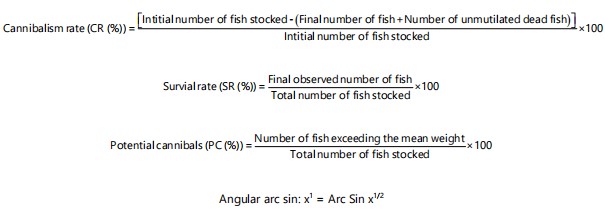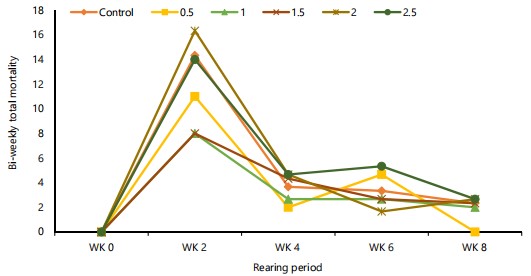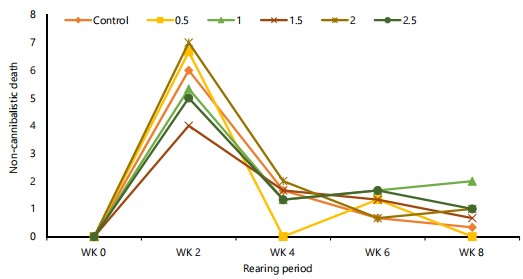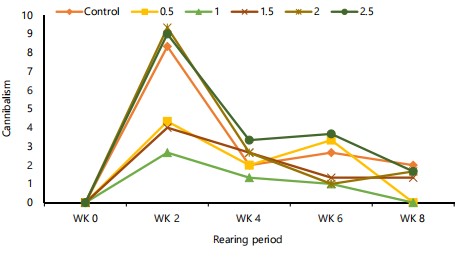Response of African Catfish Hybrid to Diets Supplemented with Varying Levels of Tryptophan
| Received 16 Apr, 2025 |
Accepted 28 Jun, 2025 |
Published 30 Sep, 2025 |
Background and Objective: The hybrids of the African catfish are commonly cultured in Africa, but cannibalism exhibited by the fish generally limits their production. Many efforts to address the situation have had limited success. Tryptophan has been added to the feeds of certain fish to mitigate cannibalism with some success. This work assessed the possibility of controlling cannibalism in cultured Heterobranchus longifilis×Clarias gariepinus with dietary tryptophan. Materials and Methods: Six diets were prepared to contain in each a particular concentration of tryptophan from 0.0-2.5%, differing by 0.5% from the next feed. The hybrid fingerlings were placed 45 L in a 45 L round plastic tank containing 40 L of water, maintained by 100% flow-through water exchange per day. Feeding was 4% of body weight daily. A complete randomized design with 6 feed treatments and 3 replicates was employed. Weight and survival data were taken and the results analyzed with ANOVA (p = 0.5). Results: There were significantly higher survival rates and lowest cannibalism at 0.5, 1.0 and 1.50%, which was more as a result of the percentage composition of cannibals, which were significantly different in some treatments, than the effect of tryptophan. No effects were seen in the coefficient of variation in weight, heterogeneity, and growth performance. Conclusion: The study revealed that the diets of African catfish hybrids could be supplemented with up to 1.5% tryptophan, in conjunction with other measures, to control cannibalism. It was not possible to evaluate the effect of tryptophan on other growing stages of the fish, try many other concentrations, or exceed the experimental duration. Further research should address these limitations to provide more comprehensive information to the culturists of this species.
| Copyright © 2025 Umanah and David. This is an open-access article distributed under the Creative Commons Attribution License, which permits unrestricted use, distribution, and reproduction in any medium, provided the original work is properly cited. |
INTRODUCTION
Hybrids of the African catfish, commonly referred to as Heteroclarias and their parents (Heterobranchus longifilis or Heterobranchus bidorsalis and Clarias gariepinus or Clarias anguillaris) are very prominent in African catfish culture. The cross between both genera could be in any reciprocal order of the genders to generate the hybrids. The hybrids exhibit the many cultural characteristics of the parents and demonstrate positive heterosis in addition1-3. They are prominently freshwater species that may endure brackish water, can be cultured in ponds, tanks, water flow through, and recirculating systems. They are nocturnally very active4. They are omnivorous with very strong carnivorous and cannibalistic tendencies. The propensity towards cannibalism impacts negatively on the yield and economic productivity of these hybrids, just as their parents.
In the endeavor to control cannibalism in certain cultured fishes and shellfish, several strategies have been considered. These include but are not restricted to proper feeding5-8, night feeding, sorting9,10, adoption of appropriate stocking densities11,12, and incorporation of amino acids such as glycine and tryptophan10-15.
Tryptophan is a very important amino acid for the proper functioning of vertebrates, including fish16,17. Tryptophan and its metabolites are involved/partake in many physiological networks, including protein synthesis. The neurotransmitter serotonin (5HT), the hormone melatonin, kynurenine, kynurenic acid, niacin, or quinolinic acid are its derivatives18. Its capacity to modulate aggression and stress response in vertebrates is linked to the activities of the brain hormone serotonin, impacting negatively on cannibalism with the attendant improvement in the survival of certain cultured fish19-23. Kalu and Umanah24 did not find a significant level of mitigation of cannibalism in the African catfish, Heterobranchus longifilis, raised on tryptophan-incorporated diets for eight weeks. There has not however, been no report of the effect of tryptophan supplementation in the diet of the African catfish hybrid (Heterobranchus longifilis×Clarias gariepinus) as regards cannibalism. This research is an effort to investigate and make this information available. This study aimed to assess the effectiveness of dietary tryptophan in reducing cannibalism among cultured African catfish hybrids (Heterobranchus longifilis×Clarias gariepinus). The goal was to identify suitable tryptophan inclusion levels that can enhance survival without negatively affecting growth performance.
MATERIALS AND METHODS
Study area and duration: The research was conducted at the fish farm complex of Saekufr Ventures, Obio Nsit, Mbiokporo 1, Uyo Capital City of Akwa Ibom State, with coordinates 4°68'0"N and 7°53'0"E, for 8 weeks, December 16, 2023 to February 10, 2024.
Research protocol: Crystalline tryptophan (TRP) (Xi’an Sonwo Biotech Company Ltd., China) was incorporated in equal quantities of commercial fish feeds (Aler Aqua) at various concentrations to form six different feeds, viz, A = 0% (control), B = 0.5%, C = 1.0%, D = 1.5%, E = 2.0% and F = 2.5%.
A solution of the TRP for the specific feed type was prepared by dissolving the required amount of it in 70 % alcohol and hot water. and was then sprayed on the corresponding feed according to Krόl and Zake14 and Kumar et al.22. However, only the blank hot alcohol water solution was applied to the control feed to nullify the alcohol taste diversity between the TRP-treated and non-treated feeds. The individual feeds were dried in a 37°C oven for one hour, cooled under laboratory ceiling fans, and stored in dark polythene bags inside a freezer pending feeding.
Experimental design and procedures: Fingerlings of the African catfish hybrid, Heteroclarias (Heterobranchus longifilis×Clarias gariepinus), aged six weeks, ranging 0.490-0.743 g and 3.0-4.3 cm in individual weight and length, respectively, were used. 45 fingerlings were placed in each of 18 round plastic tanks having a capacity of 45 L, with 40 L of clean, cool water in each. The tanks were pre-disinfected with 10% formalin and arranged in 6 sets according to the feed types (treatments) in 3 replications. The fish in each treatment were fed at 4% body weight (according to the replicate), split into two rations per day throughout the experiment. The experimental layout was completely randomized. Water exchange was 100% daily flow through. Mean weekly records of daily water quality indices were kept to determine the final average post-experiment. Weight measurements of fish in every tank were conducted at the beginning, fortnightly, and terminally during the study. The number of fish was similarly noted at the commencement and every weighing time. Any dead fish were removed promptly and examined for mutilation of body parts before each feeding.
Data processing: At the end of the experiment, the data collected were processed to determine various indices. All percentage data were transformed into angular arc sine before statistical analyses and back transformed25:
Where:
| ln | = | Base of the natural log | |
| t | = | total number of days less one |
Where:
| SD | = | Standard deviation of individual weight of the sample | |
| X | = | Mean of the total weight of the sample |
Where:
| CVI | = | Initial Coefficient of variation in weight (%) | |
| CV2 | = | Final Coefficient of variation in weight (%) |
Where:
| D | = | Number of unmutilated dead fish | |
| N | = | Total number of fish stocked |
 |
Where:
| x1 | = | Transformed percentage | |
| x | = | Percentage value to be transformed and Arc sin = sin¯1 |
Statistical analysis: One-way analysis of variance (ANOVA) for significant difference and Fisher’s Least Significant Difference (LSD) for means separation (p = 0.05) were performed with a computer Statistical Package for Social Sciences (SPSS) Version 25, IBM Inc., USA. Microsoft Excel (2016), Microsoft Inc., USA., was employed for graphical presentation.
RESULTS
Water quality: The observed water quality over the period was all adequate for warm water fishes, and the values were as follows:
Size variation, mortality and survival rates, and potential cannibals: Mean size variation at the commencement and end of the experiment calculated in terms of initial and final coefficients of variation (CV1 and CV2, respectively) in the length of the experimental fish and the ratio between the two calculated as heterogeneity, detailed mortality rate (MR), survival rate (SR) and percentage potential cannibal (%PC) of the experimental fish were as shown in Table 1.
The results in Table 1 show that there were no significant differences in the mean values of initial and final coefficients of variation (CV1 and CV2) mean of heterogeneity. The highest CV1 (56.69%) was in fish fed feed B, while the lowest was in fish on. As also seen in the table, the CV2 was highest (20.73%) in fish on feed F, while it was lowest (16.84%) in fish receiving the control feed A. Heterogeneity ranged between 2.25 in feed F and 3.14 in the control. The detailed mortality profile is also shown in Table 1. The means of NM in the table showed no significant differences (p<0.05), occurring most (23.7%) in E and least (16.94%) in feed, B. The cannibalism rate (CR) was between 10.84 and 39.23% in C and F feeds, respectively. The B, C, and F were significant; A, E, and F were similar; A, B, D, and E were the same, and C and D were the same too. The means of MR, SR, and PC exhibited various significant differences and similarities amongst the treatments.
Bi-weekly trend of mortality: The bi-weekly trend of mortalities that operated on the fish exposed to different dietary tryptophan treatments over 8 weeks is shown in the following figures.
The mean total mortality rate (MR) in Fig. 1 was highest in all treatments at the second week and declined in week 4 to a minimum in week 8. The highest (16.33%) was in treatment E (2.0% TRP) in week 2, and the lowest (0.0%) in week 8 among fish on feed B (0.5% TRP).
Mean natural (non-cannibalistic) mortality rate (NM), Fig. 2, was highest in all treatments in week 2 and declined steadily to a minimum in week 8. Incidentally, no mortality was recorded in fish fed feed B in weeks 4 and 8, while the lowest value (1.33%) for feed C in week 4 rose to 2.0 % in week 8.
Mean cannibalistic mortality rate (CR), Fig. 3 was generally highest in week 2 with the peak (9.33 %) among fish fed with feed E (2.0% dietary TRP). Although lethal cannibalism declined steadily, the least (0.0 %) was recorded in week 8 in fish on feeds B and C. Fish on feed B (0.5% TRP) generally recorded the lowest incidence of cannibalism, while those on feed F sustained the lead.
Growth performance: The weight indices examined and their mean values obtained are presented in Table 2.
In Table 2 there were some significant differences in the initial average weight. However, the mean final weight (Wf) exhibited no significant dissimilarity (p>0.05) across the range. Similarly, the mean weight gain (Wg) which was highest (17.77 g) for F and least (12.01 g) for C was not significantly different (p>0.05) and specific growth rate (SGR), was highest (6.06) in fish fed on E with 2.0% dietary TRP and lowest (4.39) in fish fed feed on A, the control (0% TRP) but also without any significant difference (p>0.05) in all the treatments.

|

|
| Table 1: | Mean CV, heterogeneity, mortality, survival, and potential cannibal percentage in African catfish hybrid fingerlings fed tryptophan-based diets over 8 weeks | |||
| Feed | CV2 | CV1 | Heterogeneity | NM | CR | MR | SR | PC (%) |
| A | 52.74±3.9a | 16.84±1.17a | 3.14±0.13a | 19.07±0.15a | 32.96±0.58ab | 52.68±0.96b | 47.32±0.96c | 11.05±0.04b |
| B | 56.69±6.6a | 18.67±1.34a | 3.12±0.61a | 16.94±0.07a | 22.2±0.02b | 39.25±0.02bc | 60.75±0.02b | 11.05±0.04b |
| C | 47.14±5.81a | 16.97±1.46a | 2.79±0.33a | 22.84±0.10a | 10.84±0.17c | 33.86±0.31c | 66.14±0.31a | 4.25±0.1c |
| D | 44.86±5.53a | 17.82±0.67a | 2.53±0.34a | 19.18±0.06a | 18.72±0.43bc | 38.44±0.17bc | 61.56±0.17ab | 6.55±0.07c |
| E | 50.33±6.35a | 18.24±0.84a | 2.80±0.50a | 23.7±0.010a | 31.92±0.96ab | 56.5±0.73ab | 43.5±0.73c | 10.19±0.11b |
| F | 41.82±0.3a | 20.73±3.57a | 2.25±0.50a | 19.88±0.10a | 39.23±0.07a | 59.26±0.01a | 40.73±0.01c | 13.33±0a |
| P-value | 0.479 | 0.679 | 0.675 | 0.372 | 0.019 | 0.045 | 0.045 | 0.005 |
| Significant | No | No | No | No | Yes | Yes | Yes | Yes |
| N/B: Means in the same column with different superscript letters are significantly different (p<0.05), Diet: A: 0.0% TRP, B: 0.5% TRP, C: 1.0% TRP, D: 1.5% TRP, E: 2.0 TRP, F: 2.5% TRP, NM: Natural mortality rate, CR: Cannibalism rate, MR: Total mortality rate, SR: Survival rate and PC (%): Percentage potential cannibals | ||||||||

|
| Table 2: | Mean growth indices of African catfish hybrid (Heterobranchus longifilis×Clarias gariepinus) fed diets with varying tryptophan levels over 8 weeks | |||
| Treatment | Wi | Wf | Wg | SGR |
| A | 0.63±0.03b | 18.4±3.16a | 17.76±3.13a | 4.39±0.61a |
| B | 0.66±0.03ab | 15.64±1.62a | 14.97±1.62a | 5.1±0.76a |
| C | 0.63±0.02b | 12.64±1.40a | 12.01±1.40a | 5.6±0.73a |
| D | 0.52±0.02c | 13.93±1.47a | 13.40±1.48a | 5.0±0.73a |
| E | 0.54±0.03c | 16.74±1.89a | 16.20±1.87a | 6.06±0.52a |
| F | 0.72±0.02a | 18.49±0.99a | 17.77±1.01a | 5.65±0.29a |
| P-value | 0.001 | 0.236 | 0.243 | 0.526 |
| Significant | Yes | No | No | No |
| N/B: Means in the same column with different superscript letters are significantly different (p<0.05), Wi: Initial mean weight, Wf: Final mean weight, Wg: Mean weight gain, SGR: Specific growth rate | ||||
DISCUSSION
The predatory foraging mode, cannibalism, widely displayed by the African catfish, is a great challenge in farming this fish. Tryptophan-supplemented diets fed to the African catfish hybrid were noticed to have reduced cannibalism and improved survival at 1.0%, followed by 1.5% and 0.5% in this study, but growth performance and size heterogeneity were unaffected. This phenomenon of cannibalism is believed to be possibly associated with aggression, size disparity26 and a host of other factors27, and has been exposed to many options to mitigate it, but with various implications. Certain authors have attempted to feed fish with feeds containing tryptophan16,28,21. Minimized levels of cannibalism and improved rates of survival in juvenile grouper (Epinephelus coioides) and Asian seabass (Lates calcarifer) were earlier observed20,22, respectively. Sepúlved-Quiroz et al.29 reported that Gar (Atractosteus tropicus) larvae maintained on 10 g/kg tryptophane augmented feed had reduced cannibalism and a higher survival rate than the control.
In the present study, the survival rate was highest in fish fed with diet containing 1.0% tryptophan, which also recorded the least level of cannibalism and percentage of potential cannibals. The performance of these fish was closely followed by those on 1.5 and 0.5%. However, the fish group that received the highest level of tryptophan exhibited the highest significant cannibalism and the lowest significant survival rate. Similar results were obtained by Kumar et al.22. The diverse concentrations reported to be effective
in mitigating cannibalism in different species tried could imply that the tryptophan might have different thresholds in different fish species. de Pedro et al.30 found that TRP supplemented at 0.6 mg/L reduced cannibalism and improved survival in the fry of the striped murrel (Channa striatus). The 2 ppm was optimal for the growth, cannibalism control, and survival of Pabda fry. It has been reported that the high uptake of tryptophan by some stocks of cultured fish seems to impact the heterogeneity by reducing the coefficient of variation20,29. High levels of serotonin could depress the consumption of food, with the consequence of reduced growth in fish19,31-33. The effect is probably more on the bigger fish with the higher feed consumption rate19. However, such an effect in this particular work was quite minimal, and the significant percentage of potential cannibals still subsisting among the population of the group on a 2.5% tryptophan-enriched diet probably elevated the cannibalism pressure above others. The trend in the cannibalism rate, therefore, appeared not attributable to the effects of the TRP, but rather highly reflective of the percentage composition of potential cannibals in the various treatments. Given this situation, it would be necessary to corroborate4,6,9 that the severity of type cannibalism is influenced by fish size distribution and the number of cannibals (larger fish) in the stock. Following this line of argument would therefore suggest that dietary TRP supplementation was not effective in reducing cannibalism in this fish. The cannibalism rate of 10.84-39.23% observed in this work is still congruent with cannibalism in the African catfish culture not exposed to cannibalism control. For example, a cannibalism rate of 6.6-20.0% in Clarias gariepinus fingerlings reared in 25 L plastic tanks and fed with commercial feeds at 2-12% fish biomass5. The initial as well as the final weight of the fish was somewhat homogeneous and not significant, as indicated by CV1 and CV2 among the various treatments. There was, however, wider size dispersal in CV2 than in CV1 as seen in the heterogeneity greater than 1+(100 %), implying that TRP did not even reduce size variability of fish within treatment, let alone across all treatment frontiers. TRP influence on reducing size differential in Pike perch post larvae was also found to be inconsequential14. This was rather contrasting to the reports20,22 on L. calcarifer that dietary TRP supplementation affected low CV in the stock, which contributed to reduced intensity of cannibalism.
Normal mortalities recorded in the work were fairly high due to the culture system employed however, this was not significant and did not impact the results. The levels of dissolved oxygen, pH, and temperature were adequate. Mortalities might have resulted from a probable slight departure of nitrite and ammonia from normalcy, considering a partial flow through a system that could not adequately regulate these parameters to ideal levels. Nitrite concentration of 0.1 mg/L is considered stressful, while 1 mg/L proves lethal to aquatic organisms34. Similarly, ammonia concentration beyond 0.3 mg/L is believed to be toxic35. The values and significant patterns of total mortality and survival rates recorded in the work were accounted for by cannibalistic mortalities that operated on the stock. This observation could draw credence from the previous report36 that cannibalism is more responsible for mortality during nursery rearing of predatory fishes, even when the rearing conditions approximate ideal situations and resources are adequate5,26. However, 1.0% TRP produced the lowest significant cannibalism rate but failed to achieve any significant superiority over 1.5% with its highest survival rate.
The dynamics of cannibalistic and natural mortalities over the 8 week culture period presented a crescendo between the first and third week of rearing, possibly as this period synchronized the time of highest size heterogeneity and density of fish. Stock size, dispersal, and density have been classified among determinant factors in fish cannibalism and survival under culture conditions27. Handling stress and adaptation to the modified feed could contribute to high natural mortality and cannibalism on weak individuals during this period. Also, at this time, any possible cannibalism inhibiting effect of the dietary supplemented TRP might not have been possible as the concentration of TRP in the plasma might be too low to achieve any serotonergic activity in the brain of the fish.
There have been conflicting reports concerning the implications of dietary TRP supplementation on the growth performance of fish and shellfish. Fewer studies,19,20,31, noticed significant growth difference in their works, but fewer studies13,14,22,29 and did not33. The various effects might be a function of species, experimental conditions, or application rates.
CONCLUSION
The study concluded that dietary supplementation with up to 1.5% tryptophan improved survival and reduced cannibalism in African catfish hybrids. However, the results suggest that this effect may be linked more to the size composition of fish rather than tryptophan alone. No significant effects were observed on growth performance, weight variation, or size heterogeneity. Therefore, tryptophan should be used alongside other control strategies. Future research should explore different concentrations, longer durations, and additional growth stages to better assess its overall impact.
SIGNIFICANCE STATEMENT
This study discovered the potential of dietary tryptophan supplementation in controlling cannibalism among African catfish hybrids (Heterobranchus longifilis×Clarias gariepinus), which can be beneficial for improving survival rates and overall production efficiency in aquaculture systems. By identifying effective tryptophan inclusion levels (0.5, 1.0, and 1.5%), the research provides a practical, non-invasive strategy for managing aggressive behavior in farmed fish. Although the impact on growth performance and weight heterogeneity was limited, the role of fish size distribution in cannibalism incidence was highlighted. This study will help researchers to uncover the critical areas of behavioral modulation in aquaculture species that many researchers were not able to explore. Thus, a new theory on nutritional behavior management in cultured fish may be arrived at.
REFERENCES
- Solomon, R.T. and S.M. Taruwa, 2011. The growth comparison of two catfishes (C. gariepinus and Heteroclarias). Nat. Sci., 9: 138-148.
- Owodeinde, F.G., K.A. Fakoya and M.A. Anetekhai, 2012. Growth performance of hybrid Catfish (Clarias gariepinusx Heterobranchus bidorsalis) in earthen ponds. Asian J. Biol. Sci., 5: 192-200.
- Abanikannda, O.T.F., A.A. Jimoh, A.A. Abagun and L.A. Badmus, 2019. Comparative study of growth parameters of African catfishes as panacea for food security. Niger. J. Anim. Sci., 21: 179-192.
- Almazán-Rueda, P., A.T.M. van Helmond, J.A.J. Verreth and J.W. Schrama, 2005. Photoperiod affects growth, behaviour and stress variables in Clarias gariepinus. J. Fish Biol., 67: 1029-1039.
- Marimuthu, K., R. Umah, S. Muralikrishnan, R. Xavier and S. Kathiresan, 2011. Effect of different feed application rate on growth, survival and cannibalism of African catfish, Clarias gariepinus fingerlings. Emir. J. Food Agric., 23: 330-337.
- Kubitza, F. and L.L. Lovshin, 1999. Formulated diets, feeding strategies, and cannibalism control during intensive culture of juvenile carnivorous fishes. Rev. Fish. Sci., 7: 1-22.
- Ribeiro, F.F., S. Forsythe and J.G. Qin, 2015. Dynamics of intracohort cannibalism and size heterogeneity in juvenile barramundi (Lates calcarifer) at different stocking densities and feeding frequencies. Aquaculture, 444: 55-61.
- Ljubobratovic, U., B. Kucska, T. Feledi, V. Poleksic and Z. Markovic et al., 2015. Effect of weaning strategies on growth and survival of pikeperch, Sander lucioperca, larvae. Turk. J. Fish. Aquat. Sci., 15: 325-331.
- Baras, E. and M. Jobling, 2002. Dynamics of intracohort cannibalism in cultured fish. Aquacult. Res., 33: 461-479.
- Maradun, H.F., S.O. Ovie, J.Z. Ibrahim, U.B. Abdullahi and S.S. Nasiru, 2019. Effect of frequency of sorting on the growth and production of heteroclarias fingerlings. Global Sci. J., 7: 631-635.
- Sogbesan, O.A., Z.A. Aderolu and M.W. Panya, 2009. Performances of dutch claries juvenile stocked at different densities in out-door happas. World Rural Obs., 1: 17-23.
- Solomon, R.J. and F.C. Udoji, 2011. Cannibalism among cultured African catfishes (Heterbranchus longifillis and Clarias gariepinus). Nat. Sci., 9: 1-13.
- Suharyanto, Y. and Y. Himawan, 2015. Applications tryptophan and glycine in feed and its effect on the level of post larva cannibalism and survival rate of giant prawn (Macrobrachium rosenbergii, de Mann). J. Aquacult. Mar. Biol., 3: 318-321.
- Król, J. and Z. Zakęś, 2016. Effect of dietary L-tryptophan on cannibalism, survival and growth in pikeperch Sander lucioperca (L.) post-larvae. Aquacult. Int., 24: 441-451.
- Wolkers, C.P.B., M. Serra, R.E. Szawka and E.C. Urbinati, 2014. The time course of aggressive behaviour in juvenile matrinxã Brycon amazonicus fed with dietary L-tryptophan supplementation. J. Fish Biol., 84: 45-57.
- Ahmed, I., I. Ahmad and B.A. Malla, 2024. Effects of dietary tryptophan levels on growth performance, plasma profile, intestinal antioxidant capacity and growth related genes in rainbow trout (Oncorhynchus mykiss) fingerlings. Aquaculture, 585.
- Hoseini, S.M., A.P. Jiménez, B. Costas, R. Azeredo and M. Gesto 2019. Physiological roles of tryptophan in teleosts: current knowledge and perspectives for future studies. Rev. Aquacult., 11: 3-24.
- Peng, C. and R.E. Peter, 1997. Neuroendocrine regulation of growth hormone secretion and growth in fish. Zool. Stud., 36: 79-89.
- Winberg, S., Ø. Øverli and O. Lepage, 2001. Suppression of aggression in rainbow trout (Oncorhynchus mykiss) by dietary L-tryptophan. J. Exp. Biol., 204: 3867-3876.
- Hseu, J.R., F.I. Lu, H.M. Su, L.S. Wang, C.L. Tsai and P.P. Hwang, 2003. Effect of exogenous tryptophan on cannibalism, survival and growth in juvenile grouper, Epinephelus coioides. Aquaculture, 218: 251-263.
- Höglund, E., M.J. Bakke, Ø. Øverli, S. Winberg and G.E. Nilsson, 2005. Suppression of aggressive behaviour in juvenile Atlantic cod (Gadus morhua) by L-tryptophan supplementation. Aquaculture, 249: 525-531.
- Kumar, P., M. Kailasam, S.N. Sethi, K. Sukumaran and G. Biswas, 2017. Effect of dietary L-tryptophan on cannibalism, growth and survival of Asian seabass, Lates calcarifer (Bloch, 1790) fry. Indian J. Fish., 64.
- Sahu, S., S. Ngasotter, M. Mog, S. Tesia, S. Sharma, B. Dayakar and D. Waikhom, 2020. A review on physiological, behavioral and metabolic role of dietary tryptophan in fish. Int. J. Chem. Stud., 8: 2411-2417.
- Kalu, O.A. and S.I. Umanah, 2024. Dietary tryptophan supplementation made no difference on the cannibalism, survival and growth of Heterobranchus longifilis fingerlings. Int. J. Life Sci. Agric. Res., 3: 7-13.
- McDonald, J.H., 2014. Data transformations. In: Hand book of Biological Statistics, McDonald, J.H. (Ed.), Sparky House Publishing, Baltimore, USA.
- Hecht, T. and A.G. Pienaar, 1993. A review of cannibalism and its implications in fish larviculture. J. World Aquacult. Soc., 24: 246-261.
- Duk, K., J. Pajdak, E. Terech-Majewska and J. Szarek, 2017. Intracohort cannibalism and methods for its mitigation in cultured freshwater fish. Rev. Fish Biol. Fish., 27: 193-208.
- Winberg, S. and G.E. Nilsson, 1993. Roles of brain monoamine neurotransmitters in agonistic behaviour and stress reactions, with particular reference to fish. Comp. Biochem. Physiol. C: Pharmacol. Toxicol. Endocrinol., 106: 597-614.
- Sepúlveda-Quiroz, C.A., G.M. Pérez-Jiménez, G.G. Asencio-Alcudia, O. Mendoza-Porras and L.D. Jiménez-Martínez et al., 2024. Tryptophan reduces intracohort cannibalism behavior in tropical gar (Atractosteus tropicus) larvae. Fishes, 40.
- de Pedro, N., M.L. Pinillos, A.I. Valenciano, M. Alonso-Bedate and M.J. Delgado, 1998. Inhibitory effect of serotonin on feeding behavior in goldfish: Involvement of CRF. Peptides, 19: 505-511.
- Papoutsoglou, S.E., N. Karakatsouli and G. Chiras, 2005. Dietary L-tryptophan and tank colour effects on growth performance of rainbow trout (Oncorhynchus mykiss) juveniles reared in a recirculating water system. Aquacult. Eng., 32: 277-284.
- Papoutsoglou, S.E., N.K. Karakatsouli and P. Koustas, 2005. Effects of dietary L-tryptophan and lighting conditions on growth performance of European sea bass (Dicentrarchus labrax) juveniles reared in a recirculating water system. J. Appl. Ichthyol., 21: 520-524.
- Król, J., W. Flisiak, P. Urbanowicz and D. Ulikowski, 2014. Growth, cannibalism, and survival relations in larvae of European catfish, Silurus glanis (Actinopterygii: Siluriformes: Siluridae)-attempts to mitigate sibling cannibalism. Acta Ichthyol. Piscatoria., 44: 191-199.
- Roques, J.A.C., E. Schram, T. Spanings, T. van Schaik and W. Abbink et al., 2015. The impact of elevated water nitrite concentration on physiology, growth and feed intake of African catfish Clarias gariepinus (Burchell 1822). Aquacult. Res., 46: 1384-1395.
- Schram, E., J.A.C. Roques, W. Abbink, T. Spanings and P. de Vries et al., 2010. The impact of elevated water ammonia concentration on physiology, growth and feed intake of African catfish (Clarias gariepinus). Aquaculture, 306: 108-115.
- Biswas, P.R.P., A.B. Patel and H. Saha, 2018. Effect of dietary incorporation of chemo-attractants on growth and survival during seed rearing of Ompok bimaculatus (Bloch). Turk. J. Fish. Aquat. Sci., 18: 491-499.
How to Cite this paper?
APA-7 Style
Umanah,
S., David,
G. (2025). Response of African Catfish Hybrid to Diets Supplemented with Varying Levels of Tryptophan. Trends in Agricultural Sciences, 4(3), 219-228. https://doi.org/10.17311/tas.2025.219.228
ACS Style
Umanah,
S.; David,
G. Response of African Catfish Hybrid to Diets Supplemented with Varying Levels of Tryptophan. Trends Agric. Sci 2025, 4, 219-228. https://doi.org/10.17311/tas.2025.219.228
AMA Style
Umanah
S, David
G. Response of African Catfish Hybrid to Diets Supplemented with Varying Levels of Tryptophan. Trends in Agricultural Sciences. 2025; 4(3): 219-228. https://doi.org/10.17311/tas.2025.219.228
Chicago/Turabian Style
Umanah, Saviour, and Gift David.
2025. "Response of African Catfish Hybrid to Diets Supplemented with Varying Levels of Tryptophan" Trends in Agricultural Sciences 4, no. 3: 219-228. https://doi.org/10.17311/tas.2025.219.228

This work is licensed under a Creative Commons Attribution 4.0 International License.




